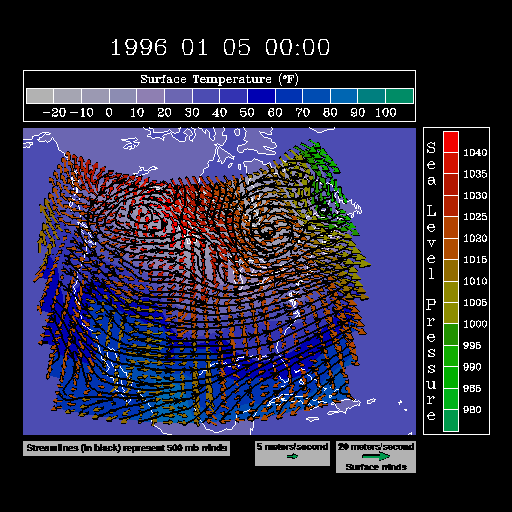NCL > Application examples > Basic examples
StreamlinePlot example 4
How to overlay streamlines of wind vector data on a map projection
This StreamlinePlot example can be created using HLU C library calls, HLU FORTRAN library calls, or NCL. It demonstrates how to overlay streamlines on vectors over a map projection. The names of the source files for this example are st04c.c, st04f.f, and st04n.ncl.
Discussion
This module discusses how to create this plot using using HLU function calls or NCL. A resource file is included with this example, and it is called st04.res. This file is used to change the default resource settings for the plot. Some of the StreamlinePlot line resources are tweaked in the resource file to show how to make appearance changes.This example shows a StreamlinePlot of 500 mb wind vector data overlaid on a MapPlot. The streamlines are drawn over a VectorPlot of surface winds colored by surface pressure that in turn is drawn over a filled ContourPlot of surface temperature. Different intervals of the "temp1" colormap are used to color the contour levels and the vectors. The data represents 15 days of weather over North America in January, 1996. The data is extracted from NMC forcast data produced at 12 hour intervals and converted to netcdf format by Unidata. Most of the time steps in the files extracted from the original data are taken from the 0 and 6 hour forecast times. However, because some of the original files were lost, certain time steps come from longer range forcasts. Also, several steps had to be excluded from the frame set because the data is defective. The result is that there is an apparent discontinuity between some of the frames when the output is animated.
Creating the plot using HLUs
The HLU C program that generates this plot is called st04c.c.
Creating the plot using HLU FORTRAN library calls
The HLU FORTRAN program that generates this plot is called st04f.f.
Creating the plot using NCL
The NCL script that generates this plot is called st04n.ncl.
The data
The data for this plot are from several netCDF files: "Ustorm.cdf","Vstorm.cdf","Pstorm.cdf","Tstorm.cdf","U500storm.cdf", and "V500storm.cdf".The data files are located in your NCAR Graphics data directory in a subdirectory called "cdf". You can get the name of the data directory by typing "ncargpath data" at your shell prompt. If you have netCDF installed on your system, then you can change directory to where the netCDF files reside and type "ncdump -h file.cdf" to view the header information for this data file.
How to run this example
This example can be created using a C program (st04c.c), a FORTRAN program (st04f.f), or an NCL script (st04n.ncl). The examples are installed in the following locations:
- $NCARG_ROOT/lib/ncarg/hluex/streamlineplot/st04c.c
- $NCARG_ROOT/lib/ncarg/hluex/streamlineplot/st04f.f
- $NCARG_ROOT/lib/ncarg/nclex/streamlineplot/st04n.ncl
- $NCARG_ROOT/lib/ncarg/resfiles/streamlineplot/st04.res
- $NCARG_ROOT/lib/ncarg/data/cdf
